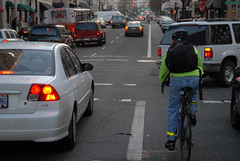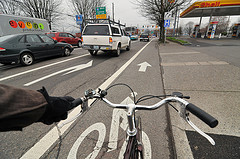A new research report, Bicycling Trends and Policies in Large North American Cities prepared for the U.S. Department of Transportation, has found that Portland leads the pack in bike-friendliness among nine bike-centric cities in the U.S. and Canada.
The report, which takes a comprehensive look at all facets of cycling in Chicago, Minneapolis, Montréal, New York, Portland, San Francisco, Toronto, and Vancouver, was done by noted researchers John Pucher and Ralph Buehler.
Sharing the report with us via email last night, Pucher commented that, “As you will see, Portland comes out very, very well: THE BEST of all North American cities, by far.”
Pucher and Buehler looked at trends in bike ridership levels, safety, infrastructure, and policies over a 20 year period. They found that the number of bike commuters in the USA rose by 64% from 1990 to 2009, and the bike share of commuters rose from 0.4% to 0.6% (for comparison, in the shorter period of 1996 to 2006, the number of bike commuters in Canada rose by 42%, and the bike share of commuters rose from 1.1% to 1.3%.)

cars still dominate much of the urban
landscape. Here’s the view from a
major bike route in downtown Portland.
For each of the nine case study cities, the researchers offer a summary of each city’s, “innovations and lessons for other cities trying to increase cycling.”
Of Portland, they write in the Executive Summary:
“Portland does almost everything, but it is most notable for its bike boulevards, dense bikeway network, innovative bike corrals, large number of cycling events, and lively bike culture…
Portland is the American city that comes closest to implementing a truly comprehensive, well-integrated, long-term package of infrastructure, programs, and policies to promote cycling. Portland’s success is evident in the numbers, with a 6-fold increase in cycling levels since 1990, compared to a doubling in New York.”
Speaking of New York City, the city that has dominated the national discussion around bicycling lately due to bold measures taken by their DOT Commissioner and more recently the “bikelash” and lawsuit that has bubbled up as a result, the report has this to say:
“New York is a special case. Not only is New York by far the largest of the case study cities, but it has the most mixed record on cycling policies and accomplishments. Although cycling has almost doubled in New York City since 1990, it lags far behind the other case study cities in almost every respect. It has the lowest bike share of commuters, the highest cyclist fatality and injury rate, and the lowest rate of cycling by women, children, and seniors. New York has built the most bikeways since 2000 and has been especially innovative in its use of cycle tracks, buffered bike lanes, bike traffic signals, bike boxes, and sharrowed streets. Yet New York has almost completely failed in the important areas of bike-transit integration and cyclist rights and falls far short on bike parking and cycling training. Moreover, the refusal of New York’s police to protect bike lanes from blockage by motor vehicles has compromised cyclist safety. New York has much to learn from the other case study cities, which have implemented a far more comprehensive, integrated package of mutually reinforcing policies to promote cycling.”
This report is full of interesting lessons and comparisons. For instance, they found that climate does not appear to be a serious obstacle to increasing levels of bike use, “as shown by Portland and Vancouver, with their rainy climates, and Minneapolis and Montréal, with their long and very cold winters.” They also point out the regional differences in North American bike use, noting that the western states have by far the highest cycling rates, “while most states in the American South, from Texas all the way to North Carolina, have extremely low levels of cycling.”
According to the researchers, the success of Portland is important because, “it shows that even car-dependent American cities can greatly increase cycling by implementing the right package of infrastructure, programs, and policies.”
Coming on the heels of high praise of Portland from US DOT Secretary Ray LaHood during his visit this week, this study is yet another opportunity for us to bask in our success. While we agree that we deserve praise and Portland’s progress provides important inspiration for other cities, let’s not forget how much more work we have to do.
We need more kick in the pants and less pats on the back.
Download the full report here (PDF).


